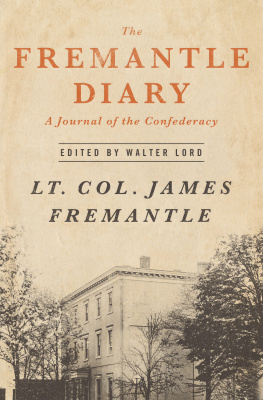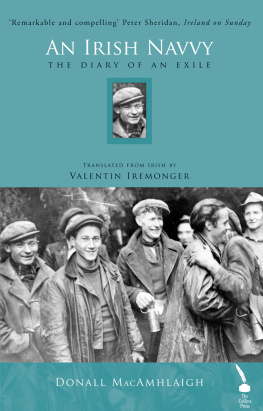It has sufficient originality to merit separate attention from Keegans diary. And it has sufficient similarity to establish the authenticity of that diary.
With all the discussion going on nowadays about the ultimate dedication of Grosse le it should furnish enlightenment on the real meaning of this Island Graveyard.
The Appendix section brings us up to date on some of the world opinion on the thinking related to this world famous burial site of thousands of Irish immigrants.
INTRODUCTION
EARLY ON THE morning of 20 May 1847, the Bark Ajax weighed anchor in Dublin harbour with over one hundred passengers on board facing a sixweek crossing of the North Atlantic to what they hoped would be a land of promise somewhere in Canada. The Ajax was a particularly small vessel carrying a load of immigrants that would ordinarily be between five and six hundred people, far more than the rated capacity of the boat. Vessels constituting what has aptly been called the coffin fleet transported over 100,000 immigrants in panic flight from famine, fever and conditions involving deprivation of all human rights. Greedy captains and shipping agents were responsible for the crowding which resulted in much suffering and enormous loss of life on the ocean.
Within a year after landing in Canada one of the passengers of the Ajax published a diary that gives remarkable details about the voyage from Dublin to Grosse le, the Canadian quarantine station. The passenger signed his name as Robert Whyte.
This diary is important for two reasons. First of all, like Gerald Keegans diary described in The Voyage of the Naparima (Mangan, 1982) it tells us at firsthand what the Irish emigrant passengers endured. And secondly, in spite of the differences in the two diaries, Whytes confirms Keegans in the similarities of experiences met by the passengers in the coffin ships. This confirmation is important in view of the attacks that have recently been made on the authenticity of Keegans diary, particularly in Ireland. It has, among other things, been classified as a work of fiction. There are obviously other reasons why one might reject this diary. The religious nature of the journal could be among these.
Unfortunately at present there is an attempt being made to turn Grosse le into a national park rather than a memorial site for the tens of thousands of Irish people who lie buried there. The people behind this movement want the former quarantine station to be an historic theme park commemorating Canada as a land of welcome and hope. Those who find this unacceptable and they are many are concerned about the thousands who ended their lives there. Furthermore, Grosse le is recognised by some as the most important and evocative Great Famine site on earth. There was neither welcome nor hope for the thousands who lie buried in Canadas island graveyard.
An article in the Montreal Gazette of 21 May 1992 expressed this concern. This article together with an address to a Montreal panel by one of Torontos main supporters of Grosse le, Norita Fleming is included at the end of the diary in the Appendix section.
The author of the diary did not identify himself in any formal kind of way, though Jordans book, The Grosse le Tragedy, claims that the observations in the diary came from one who was actually an eyewitness of the tragic scenes described and who, though anonymous, was a Protestant gentleman of education and position as well as a man of humane feeling and impartial observation. On board ship he was a VIP, respected by the captain and the crew. He was apparently a professional writer intending to publish his diary. His reference to the psalms and to other inspirational writings suggests that he might even have been a cleric, though he never seems to have presided at a religious service on board. The captain, though by nature gruff, was extraordinarily deferential towards him and insisted on their eating together the meals prepared by the mistress, as she was usually called, who always travelled with him.
This diary of Whytes is an undisputed eyewitness report submitted by a professional writer. Some of us are already wondering what the enemies of Gerald Keegans diary will do about this book. Both diaries are plainly firsthand accounts of tragic occurrences if we accept the part in Keegans that was taken from the historical documents listed in the references, which are not taken from the diary.
The few changes we made are not significant. In the period in which the diary was written, it was customary to load ones text with semicolons and dashes. So we took the liberty of removing over a hundred of these distractions. We removed also a section of the text which was purely statistical and which had been referred to in other parts of the diary. In general you are being given Whytes diary as it was published in 1848.
The name of the ship on which he travelled presented a problem. All of the ships and their sailing dates were checked. The Bark Ajax appears to be the most likely as it sailed on 30 May in the morning.
Shortly after Whyte landed in Canada he apparently crossed the border into the US. This was a common practice among the Irish emigrants in their anxiety to escape from the shadow of the Union Jack, seeking what they considered a refuge from British domination.
The diary appeared in print in 1848. It is signed in the authors own handwriting. Whether or not he used a pseudonym we cannot tell but it is likely that he signed his own name. In any case, this eyewitness account of an eventful voyage on an emigrant vessel is a literary gem submitted by a professional writer. It features vivid descriptions of the spectacular scenery along the St Lawrence River and striking delineations of the passengers, including the captain and his wife, the crew and the suffering travellers.
The title Whyte chose for his diary was The Ocean Plague: The Diary of a Cabin Passenger















